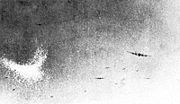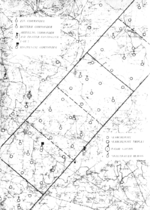
Bomber stream
Encyclopedia

Military tactics
Military tactics, the science and art of organizing an army or an air force, are the techniques for using weapons or military units in combination for engaging and defeating an enemy in battle. Changes in philosophy and technology over time have been reflected in changes to military tactics. In...
developed by the Royal Air Force
Royal Air Force
The Royal Air Force is the aerial warfare service branch of the British Armed Forces. Formed on 1 April 1918, it is the oldest independent air force in the world...
(RAF) Bomber Command
RAF Bomber Command
RAF Bomber Command controlled the RAF's bomber forces from 1936 to 1968. During World War II the command destroyed a significant proportion of Nazi Germany's industries and many German cities, and in the 1960s stood at the peak of its postwar military power with the V bombers and a supplemental...
to overwhelm the German
Luftwaffe
Luftwaffe is a generic German term for an air force. It is also the official name for two of the four historic German air forces, the Wehrmacht air arm founded in 1935 and disbanded in 1946; and the current Bundeswehr air arm founded in 1956....
aerial defences of the Kammhuber Line
Kammhuber Line
The Kammhuber Line was the name given to the German night air defense system established in July 1940 by Colonel Josef Kammhuber.- Description :...
during World War II
World War II
World War II, or the Second World War , was a global conflict lasting from 1939 to 1945, involving most of the world's nations—including all of the great powers—eventually forming two opposing military alliances: the Allies and the Axis...
.
The Kammhuber Line consisted of three layers of zones of about 32 km long (north
North
North is a noun, adjective, or adverb indicating direction or geography.North is one of the four cardinal directions or compass points. It is the opposite of south and is perpendicular to east and west.By convention, the top side of a map is north....
–south
South
South is a noun, adjective, or adverb indicating direction or geography.South is one of the four cardinal directions or compass points. It is the opposite of north and is perpendicular to east and west.By convention, the bottom side of a map is south....
) and 20 km wide (east
East
East is a noun, adjective, or adverb indicating direction or geography.East is one of the four cardinal directions or compass points. It is the opposite of west and is perpendicular to north and south.By convention, the right side of a map is east....
–west
West
West is a noun, adjective, or adverb indicating direction or geography.West is one of the four cardinal directions or compass points. It is the opposite of east and is perpendicular to north and south.By convention, the left side of a map is west....
). In each zone there were two ground-directed
Ground-controlled interception
Ground-controlled interception an air defense tactic whereby one or more radar stations are linked to a command communications centre which guides interceptor aircraft to an airborne target. This tactic was pioneered during World War II by the Royal Air Force with the Luftwaffe to follow closely...
night fighter
Night fighter
A night fighter is a fighter aircraft adapted for use at night or in other times of bad visibility...
s known as "Wild Boar" (Wilde Sau
Wilde Sau
Wilde Sau was the term given by the Luftwaffe, during World War II, to the technique by which British night bombers were mainly engaged by single-seat fighter planes.- Origins :...
). Initially, RAF Bomber Command sent in their planes
Bomber
A bomber is a military aircraft designed to attack ground and sea targets, by dropping bombs on them, or – in recent years – by launching cruise missiles at them.-Classifications of bombers:...
individually, with each navigator plotting his own route to the target, to avoid flak concentrations. However this also meant the Himmelbett centres in each cell dealt with only one or two planes at a time, for which the system was designed.

Statistics
Statistics is the study of the collection, organization, analysis, and interpretation of data. It deals with all aspects of this, including the planning of data collection in terms of the design of surveys and experiments....
analysis which would become known as operational research. The introduction of GEE
GEE (navigation)
Gee was the code name given to a radio navigation system used by the Royal Air Force during World War II.Different sources record the name as GEE or Gee. The naming supposedly comes from "Grid", so the lower case form is more correct, and is the form used in Drippy's publications. See Drippy 1946....
allowed the RAF bombers to fly by a common route and at the same speed to and from the target, each aircraft being allotted a height
Altitude
Altitude or height is defined based on the context in which it is used . As a general definition, altitude is a distance measurement, usually in the vertical or "up" direction, between a reference datum and a point or object. The reference datum also often varies according to the context...
band and a time
Time
Time is a part of the measuring system used to sequence events, to compare the durations of events and the intervals between them, and to quantify rates of change such as the motions of objects....
slot in a bomber stream to minimize the risk of collision
Collision
A collision is an isolated event which two or more moving bodies exert forces on each other for a relatively short time.Although the most common colloquial use of the word "collision" refers to accidents in which two or more objects collide, the scientific use of the word "collision" implies...
. Data
Data
The term data refers to qualitative or quantitative attributes of a variable or set of variables. Data are typically the results of measurements and can be the basis of graphs, images, or observations of a set of variables. Data are often viewed as the lowest level of abstraction from which...
provided to the British scientists allowed them to calculate that the bomber stream would overwhelm the six potential interceptions per hour that the German night fighters could manage in any one Himmelbett zone. It was, then, a matter of calculating the statistical loss from collisions against the statistical loss from night fighters to calculate how close the bombers should fly to minimise RAF losses.
At the urging of R.V. Jones
Reginald Victor Jones
Reginald Victor Jones, CH CB CBE FRS, was a British physicist and scientific military intelligence expert who played an important role in the defence of Britain in -Education:...
, Bomber Command reorganized their attacks into streams carefully positioned to fly right down the middle of a cell. The first use of the bomber stream was the first 1,000 bomber raid
Bombing of Cologne in World War II
The City of Cologne was bombed in 262 separate air raids by the Allies during World War II, including 31 times by the Royal Air Force . Air raid alarms went off in the winter/spring of 1940 as enemy bombers passed overhead. However, the first actual bombing took place on 12 May 1940...
against Cologne on the night of 30–31 May 1942.
The tactic proved successful and was used until the last days of the war, when centrally-organised German air defences had ceased to exist.

